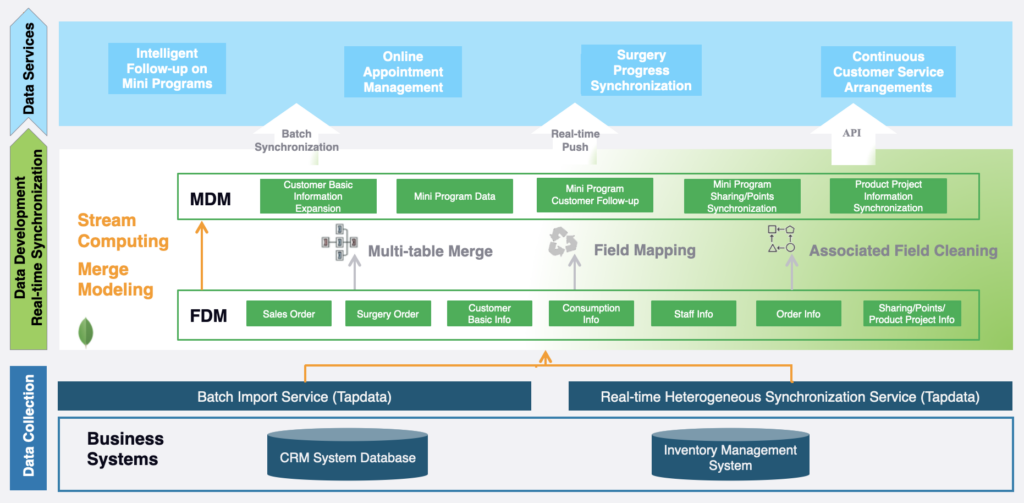In the dynamic landscape of the medical aesthetics industry, the integration of diverse data sources is crucial for informed decision-making and personalized services. This blog explores the successful application of TapData’s core product, the TapData Live Data Platform, in addressing the challenges faced by a prominent medical aesthetics institution specializing in hair transplantation.
Data Integration Challenges in Medical Aesthetics: A Transformation Journey
The institution, focusing on hair transplant procedures, encountered several challenges in implementing its digitalization strategy:
- Fragmented Customer Information:
Appointment details, treatment records, and surgical outcomes were scattered across different business systems, hindering comprehensive insights into customer profiles.
The lack of effective integration impeded the medical team’s ability to make holistic healthcare decisions and provide personalized services.
- Isolation of Technological Device Data:
Valuable data from various technological devices, such as imaging data during hair transplant surgeries and monitoring data of patient hair growth status, needed seamless integration with other system data for continuous improvement of treatment techniques.
- Lack of Synchronization between Online Platforms and Internal Systems:
The institution aimed to synchronize data from online platforms, including appointment and consultation services, with internal patient management and surgery scheduling systems in real-time.
Delays and inaccuracies in information transmission could negatively impact the patient service experience.
Navigating Challenges and Understanding Data Dynamics: Distinctive Features of the Institution’s Data
In the journey to address challenges such as data dispersion, the institution’s data presents distinctive characteristics that shape its unique landscape:
- Diverse Customer Acquisition Channels: Multiple platforms, search engines, and offline consultations resulted in challenges in analyzing and managing behavioral preferences and profiles.
- Various Operating Systems: Online applications, IoT devices, in-house CRM, and inventory systems operated concurrently, leading to dispersed data.
- Varied Data Types: The data encompassed multiple common databases like MySQL, SQL Server, MongoDB, Redis, and ES, posing challenges in integrating heterogeneous database data.
In light of the unique data characteristics, selecting an appropriate technical solution becomes a nuanced challenge.
Given the complexity of their data resources, the institution initially focused on data warehouse solutions. However, considerations extended beyond mere integration, encompassing factors such as:
- Learning Curve: The internal data team’s responsibility for tool usage highlighted the importance of a solution with a low learning curve.
- Real-time Requirements: Common data warehouse platforms in the market often fell short in meeting real-time data integration needs, posing efficiency and cost-effectiveness concerns.
Solution Requirements:
The institution outlined clear requirements for a solution:
- Real-time Data Integration: The chosen product must seamlessly integrate real-time data from various system sources for internal operational teams and downstream applications.
- User-Friendly Features: The solution should boast low learning curves, a simple interface, and easy operations to align with the preferences of the data team.
Holistic Data Integration: Transforming Fragmented Data into Strategic Insights

At the core of our strategy lies the integration of data from the Mini-Program, Hair Follicle Detection System, Customer Management System, and Inventory System. The objective is to seamlessly consolidate disparate yet interconnected data from various sources in real-time onto a centralized data platform. This initiative aims to render these data resources truly accessible, user-friendly, and reusable, leveraging their inherent value across operational facets:
- Elevating Service Quality:
- Gain a comprehensive and precise understanding of individual customer differences, medical histories, and surgical outcomes.
- Formulate more personalized hair transplant plans to enhance treatment precision and effectiveness.
- Increase customer satisfaction and overall service quality.
- Optimizing Operational Efficiency:
- Foster collaboration among internal departments and systems for streamlined workflows.
- Enhance customer processes, minimizing errors and delays in information transmission.
- Boost overall operational efficiency.
- Strengthening Decision Support:
- Provide comprehensive, real-time business data for more accurate business analysis and decision-making.
- Facilitate the formulation of scientifically grounded market strategies, strengthening market competitiveness.
- Enhancing Customer Experience:
- Integrate customer information and online appointment systems to deliver convenient, personalized services.
- Enable seamless customer interactions, from booking and consultations to tracking treatment progress.
- Elevate overall customer experience, trust, and satisfaction.
- Promoting Research and Technological Innovation:
- Integrate data from technological devices to optimize advanced hair transplant techniques.
- Monitor and analyze system data to continually refine technology, improve treatment outcomes, and drive innovation.
Internally, this integrated system facilitates unified access and precise analysis for the operations management team, enabling scientifically informed decision-making. Simultaneously, it optimizes recommendation systems, enhancing efficiency in prospect exploration for the business team, supporting rapid expansion into new ventures.
Externally, the system aids various customer channels in accessing pertinent information accurately and in real-time, ensuring transparency and optimizing user experience.
Real-Time Data Platform: A Game-Changer in Efficiency and Precision
Leveraging TapData’s robust product features, our medical aesthetics institution has efficiently implemented a real-time data platform. Outperforming self-built and other platform solutions, this approach has delivered multiple optimizations in financial, human resource, architectural flexibility, and data timeliness, truly embodying a cost-effective solution.
Illustrating the intelligent follow-up feature within its Mini Program, this functionality extends beyond online appointment customers, encompassing records from offline clinic departments. Real-time synchronization of offline clinic sales and surgery records to the customer’s Mini Program is pivotal. TapData’s real-time capabilities prevent delays in our Standard Operating Procedure (SOP) for intelligent follow-ups, optimizing SOP management and service quality.
In contrast to developing a self-built solution, our centralized data platform approach significantly streamlines real-time data synchronization from multiple sources. Reducing the solution implementation time by one month, coupled with the delivery of data in seconds, this approach efficiently propels the project forward, securing valuable time and data resource advantages in a fiercely competitive market.
These highlights only scratch the surface of the capabilities demonstrated by the real-time data platform. The untapped potential of real-time and reusable data resources awaits your exploration in collaboration with TapData.
Conclusion
TapData’s Live Data Platform emerged as the ideal solution for the medical aesthetics institution, fulfilling the need for real-time data integration while ensuring user-friendly features. The institution’s technology lead praised the platform’s visual workflow, ease of use, and robust support for diverse data sources. As the institution anticipates continued improvement, TapData’s Cloud solution remains a key driver in enhancing their data management capabilities within the ever-evolving medical aesthetics sector.


